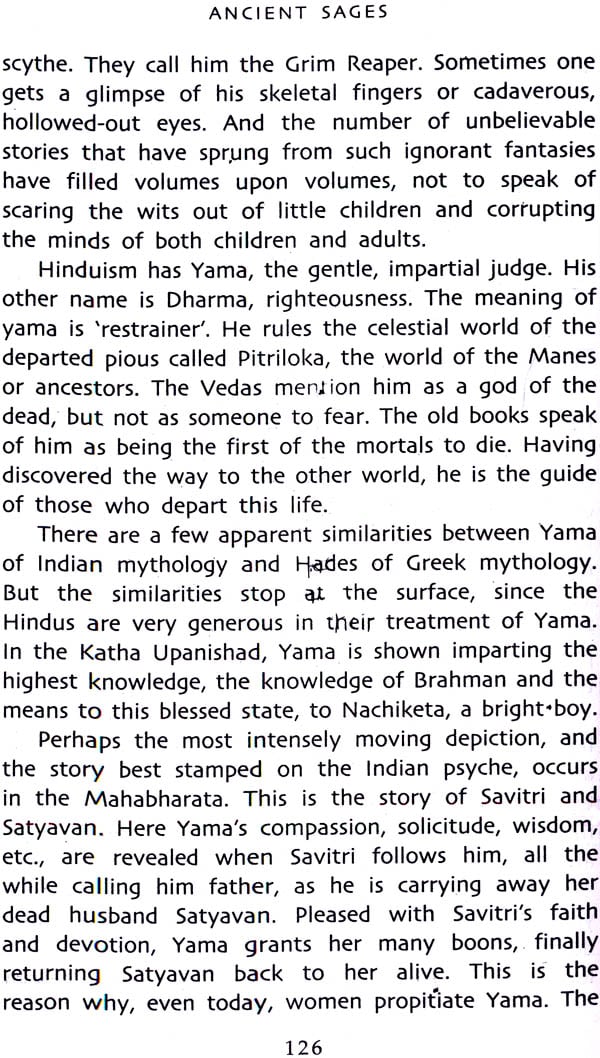
Ancient Sages
Book Specification
| Item Code: | NAF176 |
| Author: | Swami Satyamayananda |
| Publisher: | ADVAITA ASHRAM KOLKATA |
| Language: | English |
| Edition: | 2017 |
| ISBN: | 9788175053564 |
| Pages: | 223 (34 B/W Illustrations) |
| Cover: | Paperback |
| Other Details | 8.5 inch X 5.5 inc |
| Weight | 240 gm |
Book Description
Every Nation Takes pride in its ancestors, the precursors who set the note for the symphony of national life. For some countries these ancestors are politicians, for others warriors, and for still others great thinkers whose thou9hts influenced all the later people. India traces its roots to sages, rishis, and seers of truth. India was not born out of bloodshed from a sword, but rather, out of the wisdom acquired in meditation. It is proud to trace its ancestry to the half-clad sages who had nothing in this world and yet ruled the hearts of millions—sages to whom the mightiest of emperors bowed down and sought counsel from. Legend has it that one such sage scoffed at Alexander’s threats out of the conviction that he was the immortal soul which cannot be slayed.
While the present generation works hard for a better future, we should not forget our glorious past and spiritual legacy, as it is pride in our ancestors that inspires us to strive to create a better country for :hose coming after us. That is why we need to become familiar with the lives of these ancient sages, and it is also why we should pass on this legacy to the coming generations. It is with this in mind that we present this book to our readers. Indian mythology is replete with accounts of sages and seers, so some of these stories have been presented here in a short form.
These were first published in the English monthly Prabuddha Bharata from August 1997 to June 2003. The story of sage Durvasa was included later. We are grateful to William page, of Thailand, who meticulously edited this book and gave many suggestions. We also express our thanks to Alimpan Ghosh, who has drawn the illustrations. While preparing the glossary and genealogical tables, help has taken been from the Puranic Encyclopaedia by Vettam Mani and the Encylopaedia by Vettam Mani and the Encyclopaedia of Hinduism by Swami Harshananda. We believe this book will inspire readers to know more about Indian sages.
| 1 | The Four Kumaras | 9 |
| 2 | Marichi | 14 |
| 3 | Atri | 17 |
| 4 | Angirasa | 21 |
| 5 | Kratu | 26 |
| 6 | Pulaha | 29 |
| 7 | Pulastya | 32 |
| 8 | Vashishtha | 35 |
| 9 | Bhrigu Varuni | 40 |
| 10 | Ribhu | 45 |
| 11 | Vishvamitra | 48 |
| 12 | Kashyapa | 54 |
| 13 | Dattatreya | 58 |
| 14 | Kapila Muni | 63 |
| 15 | Agastya | 67 |
| 16 | Narada | 71 |
| 17 | Valmiki | 81 |
| 18 | Ashtavakra | 88 |
| 19 | Chyavana | 93 |
| 20 | Jamadagni | 99 |
| 21 | Parashurama | 105 |
| 22 | Brihaspati | 111 |
| 23 | Markandeya | 115 |
| 24 | Vaivasvata Manu | 119 |
| 25 | Yama | 125 |
| 26 | Daksha | 131 |
| 27 | Dadhichi | 135 |
| 28 | Nara-Narayana | 138 |
| 29 | Shukracharya | 142 |
| 30 | Priyavrata | 146 |
| 31 | Jadabharata | 149 |
| 32 | Shandilya | 157 |
| 33 | Yajnavalkya | 161 |
| 34 | Durvasa: The Angry Sage | 168 |
| 35 | Glossary | 173 |
| 36 | Genealogy | 215 |







